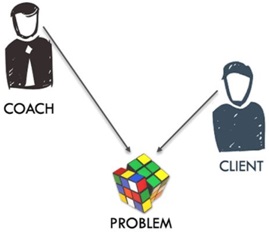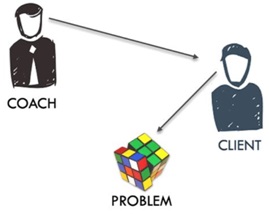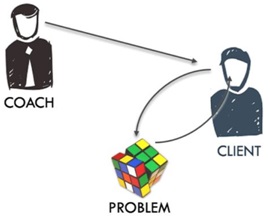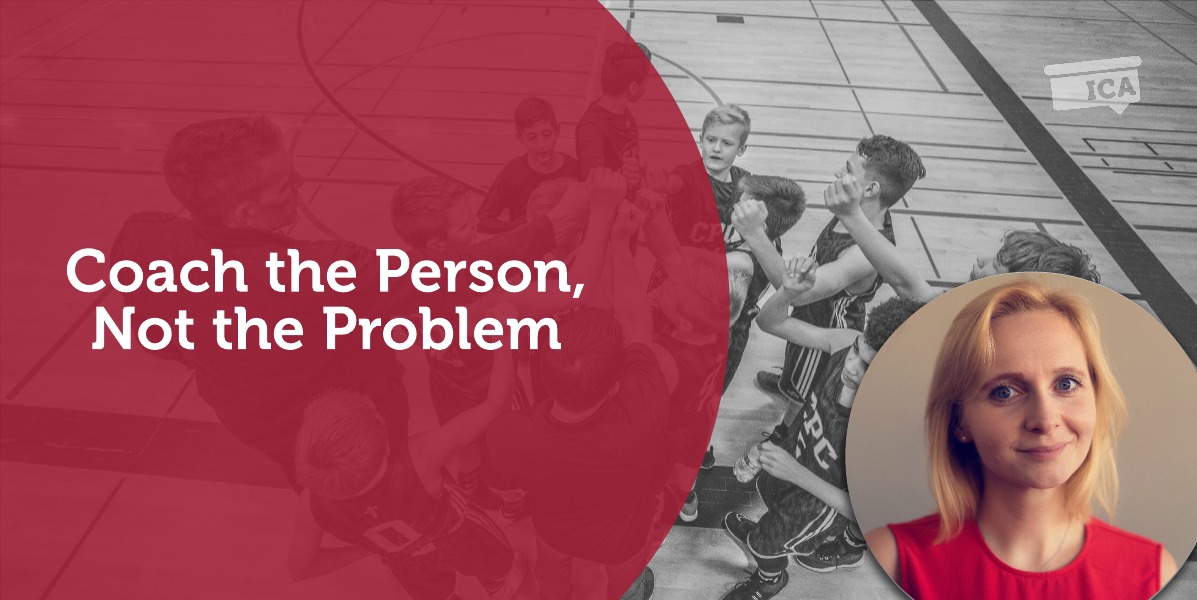A Coaching Tool Created by Dijana Kokai
(Career Coach, SWITZERLAND)
Introduction
During my journey at ICA and becoming a coach, one of my biggest challenges was to listen to the person and not the problem. As an overachiever, problem solver, and former Consultant I used to fix everything that came my way. I came a long way to put my coachee first and do not lead them into a solution that I might envision as correct. Nevertheless, during coaching sessions, I am still struggling to not focus on the facts and figures and what does need to be done next. Therefore, this Power Tool should foremost help me deepen my knowledge about the topic ‘Coach the person, not the Problem’ and second, share my learnings with the ICA community.
Explanation
There was in a particular case, my coachee came to the coaching session and was very upset about what just happened in her life. She went on and on describing the little details of the situation she was facing. Even though I caught myself not to engage in the story itself. I had a hard time finding the ‘right’ questions. The questions that would lead her to go inwards on how she could look at this situation differently and what does that mean for herself. Despite the active listening and staying with her, I did not know what to say to get her out of this thinking in spirals and getting emotional as a result. For me, it felt like I was with her in this, instead of being at the side of the road and supporting her on the journey. The coaching hour passed by way too quickly and she did not reach her goal for the session. We both ended the coaching session unsatisfied with the result. I spent quite some time afterward reflecting on what happened, unfortunately, we have not recorded the session, so I continued replying it out of my memory and was trying to find what I could have done better.
My learnings from this session where:
- I am still learning how to be an effective coach and I should not be too hard on myself
- I will make sure to have the necessary skills to focus on the person that I am coaching and supporting them on the issue that s/he brings to the session
Application
Based on Hall’s book ‘Coach the Person, Not the Problem’, there are three ways to approach the session:
- Coach the problem
- Coach the problem through the person
- Coach the person for internal change
Coach the problem
When is a coach focusing on the problem? When the coach puts the attention on the problem and when s/he wants to know more details about the issue when instead of listening to the coachee, the coach starts thinking about the problem(Hall, 2016). As coaches, we are supposed to stay curious during the entire session and follow the client’s agenda (ICA, 2019).
The illustration below shows where the attention goes. Both the coach and the coachee are looking at the problem. By doing so, the focus is away from the coachee, thus s/he does not get any new insights or change of perspective. By trying to solve the problem for the client, it might even go that far, that the coach appears to be more qualified to solve the client’s issue. This can create a disbalance in their relationship and makes the coach appear superior. Furthermore, if the coach provides or leads to a solution, the coachee might not own the decision. The solution is solely from the coaches’ viewpoint and might not be applicable to what the coachee needs to do for themselves. Most importantly, there is no learning, no growing, or any sort of transformational change for the coachee happening(Hall, 2016).

Coach the Problem through the Person
In this approach, the coach is trying to solve the problem through the coachee. The client is still solely focusing on the problem, whereby the coach is now focusing on the client.
The way forward is that the coach invites the client to describe the problem to themselves, not the coach. What do they see, what is happening in this issue they are facing from the coachee’s point of view? (Hall, 2016) The coach is letting the client reframe their perspective, by choosing an empowering view on the situation. The following question can support the change of perspective:
- What is the learning you are having from this situation?
- What are you doing well in this situation?
- What might be the other person’s perspective on this?(ICA, 2019)
- What can you be grateful for what happened?
By doing so, the coach does not focus on the problem itself. Through inquiring the client to change its viewpoint, new insight on the issue can arise. It also supports the coachee’s ability to solve the problem on its own. The benefit of this method is:
- The client is challenged to look at the issue from various viewpoints
- The client can come up with solutions that they have not thought before
- The client develops its problem-solving abilities (Hall, 2016)
At the end of the session, the coachee might have a better picture of how to go forward with the problem or even how to resolve it altogether. Nevertheless, this approach has some shortcomings; the deeper and emotional part of the client is not explored. What does this issue trigger within them on a more insightful level is not addressed? The change is more gradual and less transformational(Hall, 2016).

Coach the person for internal change
The potential for the most transformational change arises when the coach and the coachee focus on the coachee. The issue at hand is more a reflection of how the client sees him/herself rather than the main focus of the coaching session. In this approach, the coach invites the client to concentrate on him/herself.

There are two main aspects:
Internal shifts within the coachee:
- identifying an existing limiting believe of which the client was not aware of
- seeing benefits of the situation and learning they can take on from it
- recognizing patterns from their own behavior (Hall, 2016)
Creating space for the coachee:
The coach is not constantly pushing forward. Giving the coachee time to reflect, look inwards, and sit with what had just been saying. Staying with one topic for a moment and let the coachee actively reflect on it, without feeling the need to move on to the next action point, can lead to deeper insights and awareness(ICA, 2019).
Hall provides a list of possible question that can be used to play the situation back to the coachee:
- “What does this challenge stir up inside of you?
- What does it reveal about you?
- What has to change inside of you in order for you to deal with this?
- How does this change the story you are living?”(Hall, 2016)
The main benefit of the questions above is that the client is gaining insight into itself and has the chance to create some transformational change from within.
Another method to enable internal change for the coachee is to use Appreciative Inquire. This strength-based approach, as the name indicates focuses on the strengths and seeing the coachee a resourceful human, that has already everything within them to resolve the issue at hand. The client is the storyteller of their own life, they can decide which story they want to continue to tell themselves (Positivepsychology, 2019).
During the research on this topic three main points to consider came up:
Not every coaching session needs to be transformational. It is wonderful if the client experiences deep change from within but expecting to have this in every and each meeting puts quite some expectation on the coaching session. Thus, the coachee is leading the session with its agenda and if the space is right for deep personal development it should be used, but if there is a rather straight forward goal to be reached, it should stay at this action-oriented level(Hall, 2016).
Not every transformational change is blissful. Having some deep insights and learnings about oneself can be uncomfortable, draining, and cause all sorts of negative emotions. e.g.
- Realizing its own patterns that caused pain in the past
- Becoming aware of what significant change needs to happen in the future for its own wellbeing
These are only a few possible outcomes from a transformational change. The coach should sit with the client and provide the space and support needed at that time(CNBC, 2019).
Do not forget to take action. The deep insights and the awe moments are great, but in order to have a long-lasting impact on this sort of awakenings, the client needs to take actions of some sort or form. What will be the next steps after the coaching session, how can this learning be applied, and does the coachee needs to be held accountable for it? Here is where the coach comes into play and makes sure that the coachee commits to whatever feels good and right for them. The coach is not leading, but at the same time is making sure, that the session has a clear goal and an action plan on how this is going to be put into practice(ICA, 2019).
Reflection
Personally, going through this process helped me to become more aware of the different areas – me as a coach – can focus on. The ‘Coach the Person for internal change’ notes are now an essential part when preparing for a coaching session. Just as a reminder for myself where I want my focus to go. I rarely fall back into the first approach, focusing on the problem itself. For what I am very grateful for.
It is all about the client and how s/he benefits most from the coaching session. Nevertheless, staying curios and let the client bring the agenda for every session is equally important. It is a balance to provide as much value and at the same time let the client lead through the session.
Having said that, there are coaching sessions where I – from my point of view – tick all the boxes and walk out with a smile on my face, knowing that I was of service to someone. And there are other sessions, where I reflect on my own performance and would wish to turn back the time and redo it. As stated in various ICA sessions, practice is going to bring us the needed experience to provide our clients with what they need most in the coaching sessions. Showing up, being present, and give space is already a lot (ICA, 2019). Enjoying the journey and knowing that the value we as coaches bring to the table is only going to increase over time, is something to look forward to.
List of Figures
Figure 1: Hall,2016, Coach the Problem.. 4
Figure 2: Hall,2016, Coach the Person. 5
Figure 3: Hall,2016, Coach for internal change. 6
References
CNBC. (30. 12 2019). Von News Channel: https://www.cnbc.com/2017/09/15/6-crucial-steps-for-a-powerful-personal-transformation.html abgerufen
Coach approach mysteries. (28. 12 2019). Von https://coachapproachministries.org/podcast-5-ways-to-coach-the-person-not-the-problem/ abgerufen
Forbes. (29. 12 2019). Von https://www.forbes.com/sites/hennainam/2018/01/29/are-you-coaching-the-person-or-the-problem/#400d3f411273 abgerufen
Hall, C. (2016). Coach the Person, Not the Problem. Hickory: Coach Approach Ministries.
ICA. (29. 12 2019). International Coach Academy. Von abgerufen
Positivepsychology. (30. 12 2019). Von https://positivepsychology.com/strengths-based-interventions/ abgerufen
